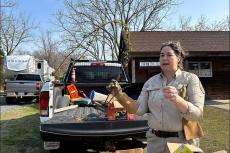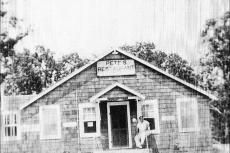This photograph from The East Hampton Star’s archive showing Elizabeth H. Dayton Cartwright (1851-1945) adorned with flowers and surrounded by white lilies, irises, and carnations evokes the eagerness many feel for the beginning of spring. Elizabeth, affectionately known to some as Aunt Libby, lived a storied life here on the South Fork.
She was born on Aug. 28, 1851, to the former Elizabeth Huntting (d. 1877) and John Dayton (1824-1884) of East Hampton. She attended Clinton Academy and Union Hall Academy in Queens, where Henry Onderdonk (1804-1886), a Long Island historian, was principal. After becoming an educator, Elizabeth moved to Montauk’s Third House, where she tutored twins born to Samuel T. Stratton (1824-1894), Annie (1866-1950) and Samuel Jr. (1866-1880).
In 1880, she married Frank A. Cartwright (1857-1919) and moved to New Jersey for several years before returning to East Hampton, where the couple had a daughter, also named Elizabeth (1885-1964).
Here Elizabeth pursued her passion for helping others through education and community service. She was an active member of the East Hampton Presbyterian Church as a Sunday school teacher, organizing the church’s first infant class, and was a member of the Ladies Missionary Society.
Her compassion extended beyond East Hampton as a member and president of the Needle Work Guild, an organization with a mission to sew clothes for those in need. In the 1890s, East Hampton’s chapter donated hundreds of pieces locally and to city hospitals.
In 1931, she began documenting her life in a series titled “Old Days and Memories of East Hampton and Montauk,” which was published in The Star through 1932. She also highlighted the lives of other residents, such as Theodore Gould (1830-1862), Cornelia Huntington (1803-1890), and Stephen (Talkhouse) Pharaoh (ca. 1821-1879).
Elizabeth’s prolific writing about the South Fork and its residents offers us great insight into the area’s rich past, and reveals to us her gregarious character, which emanates from this floral portrait, likely taken sometime in the 1930s or 1940s.
—
Megan Bardis is a librarian and archivist in the Long Island Collection.




